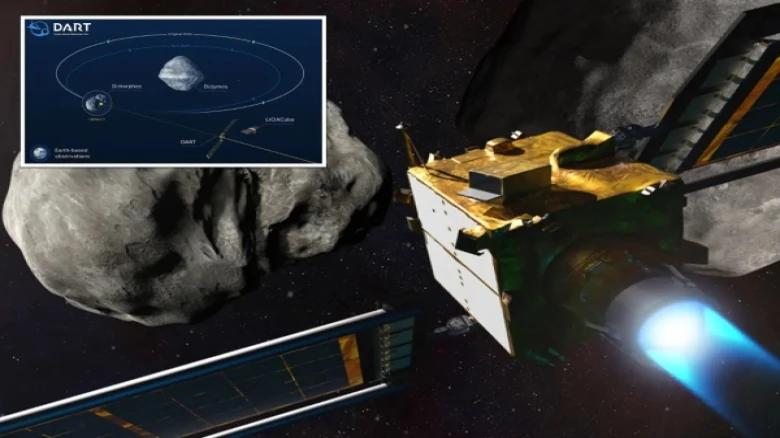The $325 million mission marked the first attempt to move an asteroid or other natural object in space.
Digital Desk: In an extraordinary dress rehearsal for the day a deadly rock threatens Earth, a NASA spacecraft slammed into an asteroid at breakneck speed on Monday.
A harmless asteroid 7.6 million miles (9.6 million kilometres) away saw the galactic grand slam as the spacecraft Dart slammed into it at 14,000 mph (22,500 kph). Scientists anticipated that the collision would modify the asteroid's orbit, create a crater, and send streams of boulders and debris into space.
To see the spectacle, telescopes on Earth and in space pointed at the same spot in the sky. Dart's radio communication quickly stopped, making the hit instantly apparent, but it will take days or perhaps weeks to assess how much the asteroid's path was altered.
The Double Asteroid Redirection Test (DART), a vending machine-sized spacecraft that was launched in November, used novel navigational techniques created by the mission manager and spacecraft builder at Johns Hopkins University's Applied Physics Laboratory.
Only an hour before impact, Dart's onboard camera, a crucial component of this clever navigation system, saw Dimorphous.
Elena Adams, a Johns Hopkins mission systems engineer, yelled, "Woo hoo!" Dimorphous is being seen, which is amazing, and wonderful.
Adams and other ground controllers in Laurel, Maryland watched with growing excitement as Dimorphos loomed larger and larger in the field of view alongside its bigger companion with an image beaming back to Earth every second.
A little satellite trailed after a few minutes later to capture images of the collision. Two weeks ago, Dart unveiled the Italian Cubesat.
Scientists insisted that Dimorphos would not be broken by Dart. Compared to the asteroid's 11 billion pounds, the spacecraft was only equipped with a paltry 1,260 pounds (570 kilogrammes) (5 billion kilograms). However, that ought to be sufficient to shorten its 11-hour, 55-minute orbit of Didymos.
A little satellite trailed after a few minutes later to capture images of the collision. Two weeks ago, Dart unveiled the Italian Cubesat.
Scientists insisted that Dimorphos would not be broken by Dart. Compared to the asteroid's 11 billion pounds, the spacecraft was only equipped with a paltry 1,260 pounds (570 kilogrammes) (5 billion kilograms). However, that ought to be sufficient to shorten its 11-hour, 55-minute orbit of Didymos.
The impact should reduce that time by ten minutes, but it will take many days to almost a month for telescopes to confirm the altered orbit. Scientists pointed out that the predicted orbital shift of 1% might not seem like much. However, they emphasised that over time, it would amount to a considerable change.
Given adequate time, planetary security specialists recommend moving a potentially dangerous asteroid or comet out of the path rather than blowing it up and creating several bits that could fall on Earth.
For large space rocks, many impactors could be required, or even a combination of impactors and hypothetical "gravity tractors," which would use their own gravity to drag an asteroid into a safer orbit.
In reference to the mass extinction that occurred 66 million years ago and is thought to have been brought on by a significant asteroid impact, volcanic eruptions, or both, NASA's senior climate adviser Katherine Calvin said, "The dinosaurs didn't have a space programme to help them know what was coming, but we do."
Since its founding by astronauts and scientists 20 years ago, the non-profit B612 Foundation has pushed for impact tests like Dart to safeguard Earth against asteroids. Despite Monday's accomplishment, the executive director of the charity and a former astronaut Ed Lu cautioned that more has to be done to discover the numerous space rocks that are still out there.
According to NASA, considerably fewer than half of the projected 25,000 near-Earth objects in the hazardous 460-foot (140-meter) range have been found. And of the millions of smaller asteroids that have the potential to cause extensive damage, less than 1% are known.
According to Lu, the National Science Foundation and the U.S. Energy Department's Vera Rubin Observatory, which is being built in Chile, will revolutionise the asteroid detection industry.
Asteroid discovery and tracking "That remains the name of the game here. That is what must occur in order to protect the Earth," he stated.

Leave A Comment